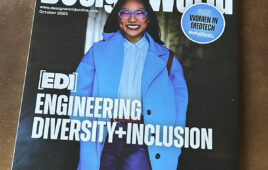 April Butterfield
April Butterfield
VP Technology, Engineered Solutions Group
Jabil
Ever since high school, April Butterfield knew she wanted to be an engineer. Math and science had always been appealing to her, because both explain how things work — while also providing problems or challenges that can be worked through and solved. Butterfield, who describes herself as naturally curious, said that coupling her curiosity with the potential to create solutions was appealing.
Her father was an engineer who worked on the Apollo space programs. Although she was young at the time, she said that even as a child, the wonder of people applying what they know to do something that had never been done was very impactful.
“As I grew, I had numerous teachers in both math and science who had a lot of influence in my leaning toward the sciences, as opposed to liberal arts,” she said. “Engineering has been a very satisfying field for me. My family would say they knew from an earlier age, as I was always asking questions and taking things apart, but for me this path became clear as a teenager.”
Butterfield, who holds a BE in Mechanical Engineering from Worcester Polytechnic Institute, is now the VP Technology for the Engineered Solutions Group at Jabil, one of the world’s largest contract manufacturers. There, she is responsible for a global group of engineers who support multiple markets — including automotive, smart home and appliances, print and retail, energy and industrial and commercial buildings.
“My colleagues are situated around the world and we support our customers by developing products and solutions from concept to volume production,” she explained. “I started my career at an OEM in the mobility field — first in mobile phones, then infrastructure products. Next, I went into the Electronics Manufacturing Services (EMS) side of the business where I have concentrated my efforts for the past 13 years.”
Butterfield, who has three grown children, said that her kids changed how she views the balance between her career and personal life.
“This balance is different for everyone and changes for individuals as circumstances change,” she said. “I have been fortunate in that I’ve achieved a balance that has worked for me, my family and my career throughout different stages.”
Getting young women involved
Butterfield said she has had the privilege of being involved in multiple STEM programs, ranging from seminars to work with schools from K-12 and colleges through to specific events. These events include involvement from Jabil’s engineering team, such as a weeklong STEM summer camp with the Girl Scouts of West Central Florida, and mentoring at the American Heart Association’s Girls Go Red for STEM event last year.
Butterfield feels that young girls need to have engineering presented as an opportunity — and the earlier, the better.
“We need earlier exposure to engineering and increased visibility of women already in the field to show inclusion in this area,” she said. “Often girls are intimidated by the perception of engineering. If exposed early, they can see the skills needed to do amazing things that can change the world are within their reach.”
However, there are still barriers for females who are interested in technical fields, and they often appear early on.
“The barrier that women face in engineering starts at a young age, while still in K-12,” she said. “If a person self-selects or is directed to avoid the more advanced or challenging math, science and engineering classes, the barrier to enter engineering later in college is significant. Reports show that the percentage of female undergraduates in engineering is one of the areas of greatest disparity between men and women.
“Women face additional challenges once in the engineering workforce, both self-inflicted and within the work environment. Specifically, these include situations where women may not speak up as readily as their male counterparts. They may perceive an exclusion attitude or approach where one may not be intended but is a result of the imbalance in the male/female ratio of a group. Women also have an approach to the group dynamic that is different and may not be well understood, so there may be more questioning of women than men when presenting information. I have seen through the years that the more diverse a group is — including other areas of diversity, such as age, race and background — the less these are areas of challenge.”
 Professional growth
Professional growth
Butterfield has faced work challenges of her own. But she has strived to learn from each barrier.
“I have had many engineering challenges throughout my career, and at the time each occurred, it was significant. I have had technical challenges with products or solutions that required collaboration from unanticipated sources to approach the problem with a different perspective to achieve resolution,” she said. “This was usually because we had exhausted all the other options the team could think of — and traveling down a different path usually resulted in schedule delays and increased cost.
“While the ultimate outcome was the resolution of the technical issue, the impact was, in some cases, very significant. With the pace of change and the reduction of time-to-market for products we see today, these types of technical challenges — big or small — leave little time for resolution. This means the approach in the early stages must consider the risks and start the action (for instance, parallel pathing multiple solutions) before the problem occurs.”
Earlier in her career, Butterfield was heavily involved in the adoption of a new technology in power amplifiers that required new approaches to components, product design, and manufacturing processes.
“My involvement was to drive solutions from design that were inclusive of the components and process solutions. This resulted in a new component package with significantly less complexity from a design and process perspective that drove lower cost and higher quality while improving the performance of the product,” she said.
“Through this process, I bettered the team by driving the collaboration across companies and disciplines. During this development, there were many times when we had negative results and had to go back to the problem and find a different approach. Doing this effectively required energy, a positive attitude, and an approach that avoided finger pointing, but rather focused on the goal. It was my responsibility to develop the technical solutions and keep the team acting as a one team with one goal.”
She noted that there are many skills necessary to be an effective leader. But she said she has learned that the most important is listening.
“A person can have the best vision for the future and detailed plan to lead down the path to realize that vision,” she said. “But without hearing and understanding the concerns and needs of the people impacted before starting and continuing that journey, the leader may end up alone in taking those steps.”
Filed Under: Engineering Diversity & Inclusion




